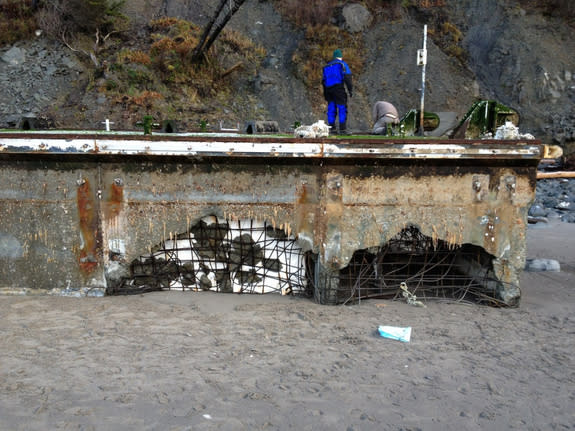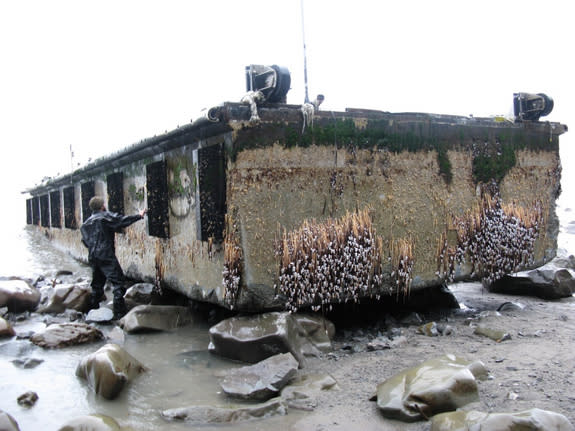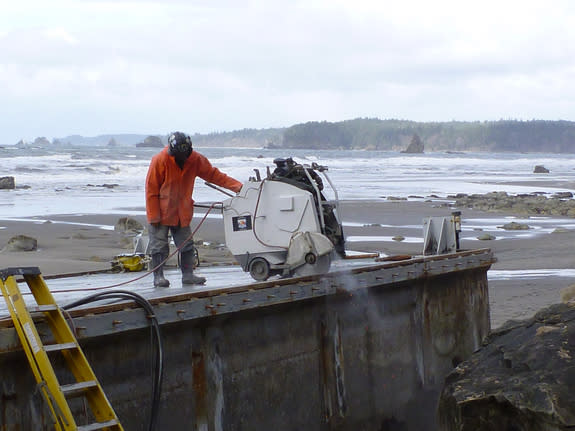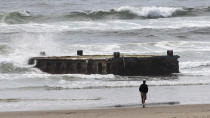Removal of Tsunami Dock Begins in Washington
A dock set adrift by the 2011 tsunami in Japan is now being dismantled and removed from the Washington state beach where it beached.
The dock washed ashore in a remote section of Olympic National Park and was found Dec. 18, 2012, by a U.S. Coast Guard helicopter search. The area was at first all but impossible to access because of high seas and a swollen stream cutting off the approach, according to the Washington state government.
Now, the Undersea Company of Port Townsend, Wash., is dismantling the dock, which measures 65 feet (20 meters) long. The sea and wind have pushed sand and cobbles around the dock, so workers will first excavate it and then use saws to cut it into manageable pieces to be helicoptered out. The work began March 19 and is expected to take several days. [See Photos of the Tsunami Dock]
Tsunami debris
Two years after the massive tsunami swept ashore in Japan, debris from the event is still trickling ashore on Pacific isles and along the Pacific coast of North America. The National Oceanic and Atmospheric Administration (NOAA) has confirmed 21 pieces of debris by serial number or other identifying marks, including the dock in Washington.
Other confirmed debris includes small, derelict boats, a 25-foot-long (11 m) steel tank and a soccer ball found by kayakers in Washington State. A second floating dock set adrift by the tsunami washed ashore in Oregon.
Marine researchers and coastal dwellers have also reported seeing an uptick in Styrofoam and housing insulation. These materials can't be definitively tied to the tsunami, but the timing and sudden influx suggests that they were part of the estimated 5 million tons of materials dragged out to sea by the tsunami.
Much of that debris, an estimated 70 percent, sunk off Japan's coast, but little is known about the remaining 1.5 million tons and how much might end up on U.S shores.
Dock dangers
The docks are of particular concern, because both harbored marine species that could potentially establish themselves on the Pacific coast. The dock that washed ashore in Oregon held about 13 pounds (about 6 kilograms) of organisms per square foot, according to Oregon State University. Marine specialists immediately set to work removing and destroying these potentially invasive species.
After the Washington dock was spotted on Dec. 18, crews managed to reach the debris on Dec. 21. Tests showed no sign of radiation from the Fukushima nuclear plant meltdown that followed the tsunami, which is typical — so far, tsunami debris has not been radioactive.
The initial crew also attached a tracking buoy to the dock to ensure it could be found if it washed back out to sea. By the time experts trekked to the dock, wind and waves had scoured most of the organisms from its sides. But in January, a team removed the floatation bumpers from the sides of the dock and decontaminated them with a bleach solution to help prevent any more potential invasives from entering the surf.
The dock weighs 185 tons and stands 7.5 feet (2.3 m) tall. It's made of Styrofoam material encased in steel-reinforced concrete. Part of the reason it was crucial to remove the dock, according to the state government, is that the dock had been damaged, allowing Styrofoam to spill out and potentially be ingested by marine mammals, fish and birds. Containing the foam will be the first priority for the removal team.
Follow Stephanie Pappas on Twitter and Google+. Follow us @livescience, Facebook & Google+. Original article on LiveScience.com.
Copyright 2013 LiveScience, a TechMediaNetwork company. All rights reserved. This material may not be published, broadcast, rewritten or redistributed.











